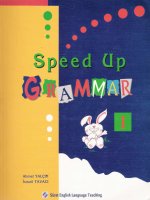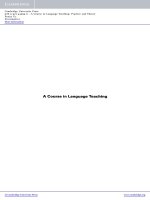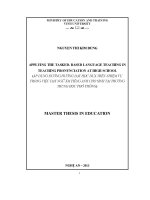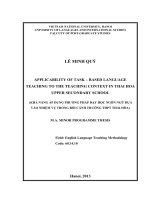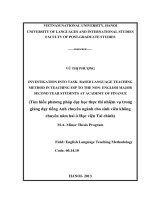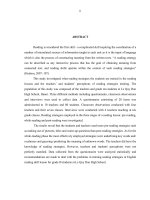ellis task based language teaching korea 20064016
Bạn đang xem bản rút gọn của tài liệu. Xem và tải ngay bản đầy đủ của tài liệu tại đây (184.16 KB, 29 trang )
Task-Based Language Teaching
Rod Ellis
University of Auckland
Three Dimensions of Language
Teaching
Goal (i.e. ‘why’ the language is being
taught)
Content (i.e. ‘what’ is taught)
- Type A syllabuses
- Type B syllabuses
Methodology (i.e. ‘how’ it is taught)
- accuracy
- fluency
Task-Based Teaching
Goal
Content
Ability to
Type B (i.e.
communicat a series of
e
messagefocused
tasks)
Methodology
Fluency (i.e.
focus on
message
conveyance)
Rationale for Using Tasks
1.
2.
Developing implicit knowledge – learners
can best develop implicit knowledge of a
second language incidentally through
the effort to communicate.
Automatization – learners can only gain
in fluency by attempting to use the L2 in
real operating conditions.
Defining a ‘Task’
1.
2.
3.
4.
A task is a goal directed.
A task involves a primary focus on meaning.
The participants choose the linguistic
resources needed to complete the task.
A task has a clearly defined outcome.
Types of Task
1.
Unfocussed tasks
a. Pedagogic
b. Real world
2.
Focused tasks
An Example of a Pedagogic
Task
1.
2.
3.
4.
Four students – each has one picture
and describes it to the rest of the class.
Students from the rest of the class ask
the four students questions about their
pictures.
One student from the class tries to tell
the story.
If necessary Steps 2 and 3 are repeated.
Some Typical Pedagogic
Tasks
Information-gap tasks (e.g. Same or
Different)
2. Opinion-gap tasks (e.g. Balloon debates)
3. Reasoning-gap tasks
4. Personal tasks
5. Role-play tasks
Note: Tasks can be dialogic or monologic;
they can be performed orally or in
writing.
1.
A Real-World Task
Look at the e-mail message below. Listen to Mr.
Pointer’s instructions on the tape. Make notes if
you want to. Then write a suitable reply to
Lesieur.
Dear Mr. Pointer
Please send flight number, date and time of arrival
and I will arrange for someone to meet you at the
airport.
Lesieur.
A Focused Task
Can you spot the differences?
B
A
A Focused Task
Can you spot the difference?
A
B
Two Approaches to Using
Tasks
1.
2.
Use tasks to support a Type A approach.
- task-supported teaching (Type A)
- weak form of communicative language
teaching
Use tasks as the basis for teaching
- task-based teaching (Type B)
- strong form of communicative teaching
Designing a Task-Based
Curriculum
1.
2.
3.
4.
Select task types according to general level.
Determine the themes/topics of the tasks
Grade tasks in terms of task difficulty
Specify language/skills/ text types required to
perform the task.
The Methodology of Task-Based
Teaching
Three phases in a task-based lesson:
1.
Pre-task phase
2.
Main task phase
3.
Post-task phase
The Pre-Task Phase
Some options:
1.
Allow the students time to plan.
2.
Provide a model
3.
Do a similar task
4.
Pre-teach key linguistic items
The Main Task Phase
Some options:
1.
Whole-class vs. small group work
2.
Set a time for completing the task.
3.
Vary the number of participants.
4.
Introduce a surprise element.
5.
Tell students they will have to present a report
to the whole class.
The Post-Task Phase
Some options:
1.
Students give a report.
2.
Repeat task (e.g. students switch groups)
3.
Consciousness-raising activities.
Focussing on Form
Opportunities to focus on form arise in taskbased teaching:
Definition:
Focus on form … overtly draws students’
attention to linguistic elements as they
arise incidentally in lessons whose
overriding focus is on meaning or
communication. (Long 1991)
cf. Focus on forms
Three Types of Focus on
Form
1.
Reactive focus on form (error correction)
2.
Teacher-initiated focus on form
3.
Student-initiated focus on form
Reactive Focus on Form: An
Example
T: What were you doing?
S: I was in pub
(2)
S: I was in pub
T: In the pub?
S: Yeh and I was drinking beer with my
friend.
Dual Focus
Learner 1: And what did you do last weekend?
Learner 2: … I tried to find a pub where you don’t
see – where you don’t see many tourists. And I
find one
Teacher:
Found.
Learner 2: I found one where I spoke with two
English women and we spoke about life in
Canterbury or things and after I came back
Teacher:
Afterwards …
Swan’s Critique of TBLT
Assumptio Critique
n
Response
TBLT does not claim this is the only way
Swan’s Critique of TBLT
Assumption
Swan’s Critique
Response
Acquisition takes place online during communication,
There is no evidence to
show that this is the only
way acquisition takes place.
It is not the only way; but it
is the most efficient way to
develop the implicit
knowledge needed for
fluent communicative use.
Conscious noticing of form
is necessary for
acquisition.
Not all acquisition involves
conscious attention to form.
TBLT is not dependent on
conscious noticing; it
caters to both conscious
and unconscious learning.
The existence of
developmental sequences
makes a structural syllabus
unworkable.
The evidence for
developmental sequences
is limited; if they do exist
they also nullify incidental
focus on form
Incidental attention to form
is extensive; some of it hits
and some of misses.
Enough hits to make it
effective for acquisition.
TBLT prioritizes the
acquisition of grammar.
Learning another language
is as much about learning
vocabulary as grammar
Agreed. TBLT serves as an
approach for developing all
aspects of an L2.
The Danger of Piginization
L1: What?
L2: Stop.
L3: Dot?
L4: Dot?
L5: Point?
L6: Dot?
LL: Point, point, yeh.
L1: Point?
L5: Small point.
L3: Dot
(From Lynch 1989, p. 124; cited in Seedhouse 1999).
But tasks can be structured to promote more complex and
accurate interaction.
The Teacher’s Role
Swan denigrates TBLT on the basis that
the teacher is relegated to the role of
manager and facilitator of interaction.
But the teacher can also be supplier of
input and also a source of feedback. Not
all TBLT lessons are learner-centred.

